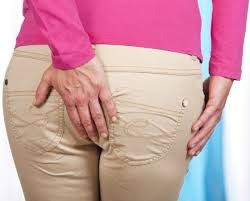HEMORRHOIDS
Hemorrhoids are a common disease. By the age of 50, about half of all adults have been faced with the itchiness, discomfort, and bleeding that can prompt the onset of hemorrhoids.
What are hemorrhoids?
You may be surprised to learn that hemorrhoids are a normal part of our anatomy. We have both internal and external hemorrhoids, located inside the anal canal and around the anus. Internal hemorrhoids carry partial blood to the anus and are made up of small artery branches. In addition, hemorrhoids are actually the lining of the anus. They assist us in controlling the release of gas and prevent the defecation of feces. They help us to distinguish what the appropriate response to both would be. External hemorrhoids are veins.
What are the symptoms of hemorrhoids?
Symptoms of hemorrhoids include:
• Painless bleeding during or between bowel movements - you may notice some bright red blood on the toilet paper or in the toilet bowl
• Pain or discomfort in the anal area, especially during or after a bowel movement

• Itching, burning, or irritation of the anal area
• Swelling around the anus
• Sensitive to toilet paper after defecation
• Protruding (prolapse) internal hemorrhoids during bowel movements. Straining or irritation as the stool passes can damage the fragile surface of the hemorrhoids and cause bleeding. Occasionally, straining can push the internal hemorrhoids out. These are known as prolapsed hemorrhoids, they can be painful and uncomfortable
• Fecal incontinence
• A lump near the anus may be painful
• The symptoms of hemorrhoids often depend on the location. The internal hemorrhoids are located inside the rectum not to be seen or touched and are usually uncomfortable. But sometimes we can have a problem due to our internal hemorrhoids. These are called "internal hemorrhoids." These symptoms can sometimes come on "suddenly" or can be chronic (long term).
• External hemorrhoids are located just below the skin around the anus. When irritated, external hemorrhoids can itch or bleed. Sometimes the bleeding becomes heavy and forms a blood clot (thrombus) that causes swelling, pain, and inflammation.
When to see a doctor?
Bleeding while having a bowel movement is the most common sign of hemorrhoids. But rectal bleeding can occur with other diseases like colorectal cancer and anal cancer. Don't assume that bleeding is from hemorrhoids without consulting your doctor.
Your doctor can examine and do other tests to diagnose hemorrhoids and rule out more serious diseases. Also, seek advice from your doctor if your hemorrhoids are causing pain, frequent bleeding, too much, or not improving with medication.
If your hemorrhoids symptoms have started with a significant change in bowel habits or if you have black, tarry, or chestnut stools, blood clots, or blood in the stool, consult your doctor immediately. This could indicate bleeding elsewhere in your digestive tract.
Seek emergency medical attention (go to the emergency room) if you experience excessive bleeding, lightheadedness, dizziness, or faintness.
What factors can lead to hemorrhoids?
The veins around your anus tend to dilate due to pressure and may bulge or swell. Hemorrhoids can form due to increased pressure in the lower rectal area. Factors that can increase pressure include:

• Straining during a bowel movement
• Diarrhea or constipation
• Sitting for a long time while going to the toilet (for example, reading or playing games while sitting on the toilet)
• A diet low in fiber
• Pregnancy and vaginal birth
• Fat

• Anal sex
• Elderly
• Thrombosed external hemorrhoids can occur after straining with a bowel movement, heavy lifting, or vigorous physical activity. Constipation or diarrhea can also cause thrombosed external hemorrhoids.
What are the complications of hemorrhoids?
Complications from hemorrhoids are rare but can include:
• Anemia: Chronic blood loss from hemorrhoids can cause anemia. This can lead to fatigue and weakness.
• Strangulated hemorrhoid: If the blood supply to internal hemorrhoids is stopped, the hemorrhoids can become " Strangulated ", causing severe pain and eventually tissue necrosis.
How are hemorrhoids diagnosed?
If you have external hemorrhoids, they are easily seen by your doctor. Tests and procedures to diagnose internal hemorrhoids may include:
• During an anal exam, the doctor looks at the skin around the anus; a lubricated finger rectal exam is gently inserted into the anus and examines the inside of the anal canal.
• In some cases, you may need a colonoscopy to make sure any colorectal disease does not cause your symptoms. This can be recommended if:
Your signs and symptoms suggest you might have another digestive system disease
You have risk factors for colorectal cancer
You are over 50 years old and have not recently had a colonoscopy
How to treat hemorrhoids?
Most hemorrhoids treated include steps you can take on your own, such as making lifestyle changes but sometimes using medicine or surgery.
Medicine: If your hemorrhoids produce only mild discomfort, your doctor can give creams, ointments, and suppositories. These products contain ingredients like hazel or hydrocortisone, which can temporarily relieve pain and itching. Do not use these medications for more than a week unless directed by your doctor. These products may cause side effects, such as skin rashes, inflammation, and thinning of the skin.
Minimal invasive procedure: If your external hemorrhoids have a blood clot (embolism), your doctor can remove the clot with a simple operation that helps relieve symptoms. For persistent bleeding or painful hemorrhoids, your doctor may recommend minimally invasive procedures that can be done at your doctor's office or other outpatient settings.
• Rubber band ligation: Hemorrhoid falls off within a week. Hemorrhoid banding can cause discomfort and bleeding 2-4 days after the procedure but are rarely serious.
• Sclerotherapy: During this procedure, the doctor injects a chemical solution into the hemorrhoids to shrink them. While the injection causes little or no pain, it may be less effective than rubber band ligation
• Coagulation (infrared, laser, or bipolar): This technique causes small, bleeding internal hemorrhoids to harden and shrivel. This technique has few side effects and a higher risk of recurrence than using a rubber band.
Surgery: Surgery can be done during the day, or you may need to stay in the hospital overnight.
• Classical hemorrhoidectomy: Various techniques can be used. Surgery can be performed with local anesthesia combined with sedation, spinal anesthesia, or general anesthesia. Hemorrhoidectomy is the most effective and complete method for treating severe or recurrent hemorrhoids. Complications can include temporary urinary retention and urinary tract infection. Most people experience pain after surgery. Medication can relieve your pain. Soaking the anus with warm water can help relieve pain.
• Hemorrhoidectomy by Longo technique: This surgery is usually less painful than a classical hemorrhoidectomy, recovering and returning to work quickly.
When do I need surgery?
Surgery for patients:
• Acute hemorrhoids, painful blood clots (embolism)
• Hemorrhoids are bleeding continuously
• Large hemorrhoids, long time, no cure
• When other treatments are unsuccessful
Feb 25, 2021
HUNG M, DO, MD, Ph.D
